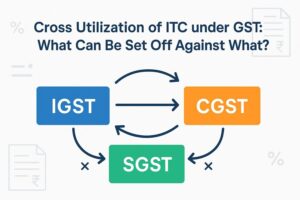How to ensure compliance with GST TDS on Composition Scheme?
- 14 Aug 24
- 14 mins

How to ensure compliance with GST TDS on Composition Scheme?
Key Takeaways
- TDS under GST applies for payments over Rs. 2.5 lakhs to suppliers, excluding GST amounts
- Deduction rates are 1% CGST + 1% SGST for intrastate supplies and 2% IGST for interstate supplies
- Entities required to deduct TDS include government departments, PSUs, and entities established by government acts
- Mandatory GST registration for TDS deductors is required, with TAN being acceptable for registration
Tax Deduction at Source means (TDS) to prevent tax evasion and ensure a steady flow of revenue to the government. Prior to GST, TDS was a well-established practice under the Income Tax Act, ensuring that taxes on certain transactions are collected upfront.
How TDS Applies to GST?
The Goods and Services Tax (GST) regime in India offers a composition scheme intended to simplify compliance for small & normal taxpayers by allowing them to pay GST at a fixed rate of turnover, rather than on every transaction. However, the application of Tax Deducted at Source (TDS) under GST to those opting for the composition scheme has specific considerations.
In general, the TDS mechanism under GST mandates that specified entities (such as government departments and agencies) must deduct a certain percentage of GST payable on the invoices for supplies received from vendors. This deduction is then deposited with the government, and the details are furnished to the supplier and the GST authorities through the filing of returns.
Application of TDS to the Composition Scheme:

TDS Deduction for Composition Dealers: Dealers enrolled under the composition scheme are subject to TDS on their taxable supplies, just like regular taxpayers. When making payments to composition dealers for taxable supplies, the deductor of tax (the entity making the contractual payment) is required to deduct TDS at the specified rate.
- Rate and Threshold: The rate of TDS under GST is generally set at 2% (1% CGST + 1% SGST for intrastate supplies or 2% IGST for interstate supplies). The threshold for TDS deduction applies to payments exceeding a certain limit, which necessitates deduction at source.
- Compliance Requirements: Composition dealers are required to provide their GSTIN to their clients or customers, who will deduct TDS and file the respective returns. Despite being under the composition scheme, the requirement to facilitate TDS deduction does not change.
- Impact on Composition Dealers: While composition dealers pay GST at a nominal rate on their turnover without claiming input tax credits, the TDS deducted on their supplies can be reflected in their electronic cash ledger. They can utilize this amount for any GST liability or request a refund, subject to GST regulations.
- Filing of Returns: Entities that deduct TDS are required to file GSTR-7 return filing, detailing the tax deducted at source. Composition dealers, on receiving TDS, will see the amounts reflected in their electronic cash ledger and must acknowledge it in their periodic filings.
Governing Acts for TDS under GST
Tax Deducted at Source (TDS) under the Goods and Services Tax (GST) framework in India is governed by specific provisions within the GST laws. These laws outline the rules, procedures, and rates for the deduction and collection of tax at source on payments made for the supply of goods and services. The primary acts governing TDS under GST include:
- Central Goods and Services Tax Act, 2017 (CGST Act)
Section 51 of the CGST Act specifically deals with TDS under GST. It mandates certain entities, such as government departments, local authorities, and certain specified persons, to deduct tax at the time of making payment to the supplier for taxable supplies of goods or services.
The section outlines the categories of entities required to deduct TDS, the rate of deduction, and other compliance requirements such as furnishing a certificate to the supplier and filing returns. - Integrated Goods and Services Tax Act, 2017 (IGST Act)
While the IGST Act primarily deals with the GST on interstate supplies, the provisions for TDS under GST are not separately mentioned in the IGST Act but are covered under the CGST Act. However, the IGST Act is relevant when the supply involves interstate transactions, and TDS is deducted accordingly at the integrated tax rate. - State Goods and Services Tax Acts (SGST/UTGST Act)
Each state and union territory in India has its own SGST or UTGST Act that works in tandem with the CGST Act to govern intrastate supplies. The provisions for TDS under the state GST laws mirror those in the CGST Act, ensuring uniformity across the country. The SGST/UTGST Acts specify the compliance and procedural requirements for TDS deduction within the respective states or union territories.
Key Provisions and Compliance Requirements
- Rates: The standard rate of tax for TDS under GST is set at 2% (1% CGST + 1% SGST/UTGST for intrastate supplies or 2% IGST for interstate supplies).
- Entities Required to Deduct TDS: Includes government departments, public sector undertakings, local authorities, and other notified entities.
- Compliance and Returns: Entities deducting TDS are required to furnish a certificate of deduction to the supplier and file a return in Form GSTR-7 within a specified period, detailing the tax deducted and deposited.
- Input Tax Credit for Suppliers: Suppliers can claim the TDS amount deducted and deposited on their behalf as an input tax credit (ITC), which can be utilized against their GST liability.
Implementation Timeline of TDS in GST
The implementation timeline for Tax Deducted at Source (TDS) under the Goods and Services Tax (GST) in India was established to come into force from the 1st of October, 2018. This was formalized through Notification No. 50/2018 - Central Tax dated 13th September 2018.
The provision mandates that specified entities, including government departments, local authorities, and certain other categories of person, individuals and organizations, are required to deduct TDS on payments made to suppliers for taxable goods and services, provided the contract value exceeds a certain threshold.
This enactment marked a significant step in the GST regime, aiming to streamline tax collection and ensure better compliance. Entities required to deduct TDS under GST must register for this purpose, irrespective of their turnover, highlighting the emphasis on tax deduction at the source for transactions within the GST framework.
The rules stipulate the due processes for deduction, payment, and reporting of TDS, underscoring the procedural rigor intended to enhance tax compliance and governance.
Entities Responsible for TDS under GST
Under the Goods and Services Tax (GST) framework in India, the responsibility for deducting Tax Deducted at Source (TDS) is specifically assigned to certain entities. As per Section 51 of the CGST Act, 2017, and corresponding notifications, these entities include:

- Government Departments and Establishments: This encompasses all departments and establishments of the Central and State Government. It does not matter whether they are involved in business activities or not; if they make payments to suppliers for taxable goods and services exceeding a specified limit, they are required to deduct TDS.
- Local Authorities: This includes municipalities, panchayats, and other local governing bodies that have administrative control over a particular area or jurisdiction.
- Public Sector Undertakings (PSUs): PSUs are companies in which the majority stake (i.e., more than 51%) is held by the government. These entities, given their scale and volume of transactions, are also tasked with deducting TDS for applicable transactions under GST.
- Societies Established by the Government or a Local Authority: Societies formed by either the central government, state government, or local authorities, under the Societies Registration Act, 1860, for the advancement of charitable activities, science, art, literature, or education, also fall under the ambit of entities required to deduct TDS.
- Authorities or Boards or Any Other Bodies: This includes any authority or board or any other body set up by an act of Parliament or a state legislature or established by any government with 51% or more participation by way of equity or control to carry out any function. This definition is broad and includes various forms of organizations and bodies created for specific functions.
Threshold for TDS Deduction in GST
The threshold limit for Tax Deducted at Source (TDS) deduction under GST is set when the value of individual supply under a contract exceeds limit from Rs. 2,50,000. This value is considered excluding the GST components like CGST, SGST, UTGST, IGST, and Cess.
TDS is thus deductible on the taxable value of the supply, and no TDS is deducted on taxes indicated in the tax invoice. Moreover, TDS is not applicable on the value of exempted goods or services, even if the exempt and taxable supplies are shown together in a tax invoice
For intra-state supplies where both the supplier and the place of supply are in the same state as the recipient, CGST & SGST would be levied and TDS would be deducted accordingly. For inter-state supplies, where the supplier, recipient, and the place of supply are in different states, IGST would be applied, and TDS would be deducted under this regime
Furthermore, the deducted TDS needs to be deposited with the government within the time limit of 10 days from the end of the month in which the deduction was made. The deductor is also required to furnish a TDS certificate to the deductee in Form GSTR-7 TDS within five days of crediting the amount to the government. Failure to comply with these provisions results in late fees and interest charges
Exemptions in TDS Applicability
Specific exemptions to TDS applicability under GST exist, primarily aimed at minimizing the compliance burden on small-scale transactions and certain exempted categories of goods and services.

In the GST framework, TDS (Tax Deducted at Source) reflects a critical compliance mechanism, underscoring the importance of meticulous adherence to tax laws. Here's an overview of TDS reflection, documentation, and the consequences of non-compliance:
TDS Reflection and Documentation
- Reflection in Electronic Ledger: The amount deducted as TDS is credited to the electronic cash ledger of the supplier. This mechanism ensures that the supplier can use this amount as a credit against their GST liability.
- Issuance of TDS Certificate: The entity that deducts TDS (deductor) is obligated to issue a TDS certificate to the supplier (deductee) in Form GSTR-7A, detailing the tax deducted. This certificate must be issued within a stipulated timeframe, usually within five days of depositing the TDS with the government.
- TDS Deposit with Government: The deductor is required to deposit the deducted TDS with the government within 10 days following the end of the month in which the deduction was made.
Non-compliance Consequence
Failure to adhere to the TDS provisions under GST can lead to several penalties and legal consequences, including:
Late Fees and Penalties: Delay in depositing TDS or failing to issue the TDS certificate within the prescribed period attracts late fees. Continuous non-compliance can result in substantial penalties.
Late or delay filing of the TDS under GST involves filing the GSTR-7 return after the due date, which is the 10th of the following month in which TDS was deducted. Late filing attracts a penalty of Rs. 100 per day under CGST and Rs. 100 per day under SGST, with a maximum cap of Rs. 5,000.
In case TDS is deducted but not paid or is paid late, interest at 18% along with the TDS amount needs to be paid. If TDS is not deducted, the same interest rate applies along with the TDS amount that was supposed to be deducted.
- Interest Charges: In addition to penalties, interest may be levied for late payment of the deducted TDS amount.
- Legal Implications: Persistent non-compliance could also lead to legal action under the GST law, further emphasizing the importance of timely compliance.
- Amendments to details in the TDS for any previous tax period can be made in subsequent GSTR-7 filings. This includes changes in the GSTIN of the deductee, the amount paid on which tax was deducted, and the amount of TDS deducted. It's important to correct errors as the details furnished in GSTR-7 are made available to the deductee in their GSTR-2A form, affecting their Input Tax Credit (ITC).
- For non-compliance such as failing to issue the TDS certificate within 5 days of depositing the TDS with the government, a late fee of Rs. 200 per day (Rs. 100 CGST + Rs. 100 SGST) is levied, subject to a maximum of Rs. 5,000.
Filing Requirements for TDS Deductors
Tax deductors are mandated to file a monthly return in Form GSTR-7 on the gst portal. This return details the TDS deducted during the month, facilitating transparency and accountability in tax administration.
TDS Before and After GST
The implementation of TDS under GST signifies an evolution from the pre-GST era, adapting the concept to fit within the unified tax structure of GST. Unlike the segmented tax structure pre-GST, TDS under GST integrates the deduction mechanism across all states and union territories, ensuring uniformity and simplification of the tax deduction process at the source across India.

This integration has enhanced the administrative efficiency of tax collection and reinforced the compliance framework within the GST regime, thereby aiding in the seamless operation of the nationwide tax system.
Conclusion
TDS under GST is a crucial component of India's tax mechanism, ensuring timely collection and reducing tax evasion. Its comprehensive framework, spanning across IGST, CGST, and SGST, mandates strict adherence from a wide array of entities, fostering a culture of compliance and transparency in the Indian tax system.
Download Pice Business Payment App now and pay all your other payments such as gst bills with credit card, rent etc and maximise your cash flow.
 By
By 

















